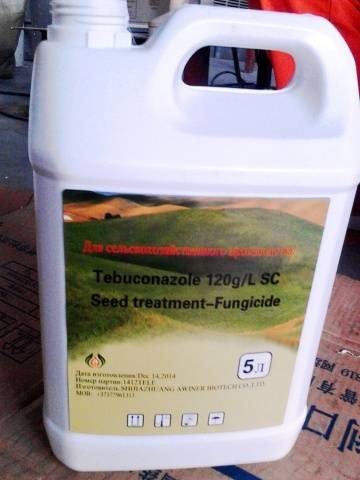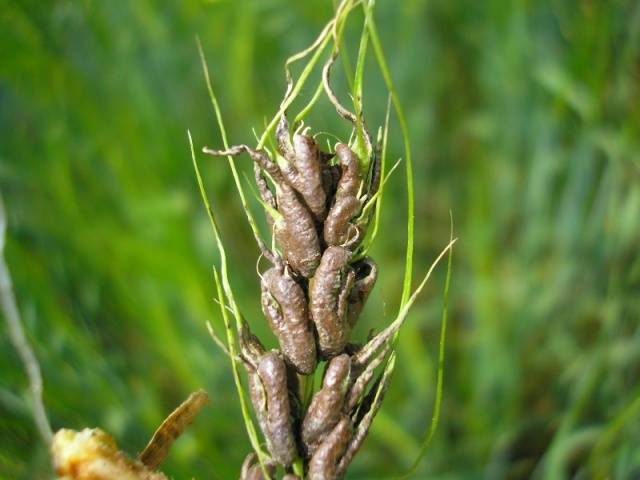Content
Fungicide Tebuconazole is a little-known, but effective drug that is designed to combat various fungal diseases of cereals, garden, vegetable and many other crops. Tebuconazole has a protective, eradication and therapeutic effect. The drug occupies one of the first places in a series of disinfectants.
Scope and form of release
Fungicide disinfects grains of wheat, barley, oats and rye. Grapes, onions, tomatoes, potatoes, beans, coffee and tea are also processed. Tebuconazole inhibits the development of a variety of fungal infections:
- helminthosporium root rot;
- grain mold;
- dusty, stone, hard, covered and stem smut;
- root rot;
- various spots;
- scab;
- alternaria;
- powdery mildew;
- leaf rust;
- fusarium snow mold.
The drug is produced in the form of a whitish suspension concentrate, which is poured into plastic canisters with a volume of 5 liters.
Mechanism of action
The active ingredient of the drug is tebuconazole, the concentration of which is 6% or 60 g of the substance per liter of suspension. Due to its high mobility, the fungicide quickly moves to the place of accumulation of parasitic fungi, eradicates the infection and provides long-term protection of crops.
The active component of the drug destroys pathogens both on the surface and inside the grain. The substance penetrates into the embryo of the seed, protects the seedlings and roots of the plant from damage by soil fungi. The drug is able to move to growth points. As soon as the fungicide solution gets on the seeds, tebuconazole suppresses the vital processes of fungi - it disrupts the biosynthesis of ergosterol in cell membranes, as a result of which they die.
The bulk of the substance passes into the plant within 2-3 weeks after sowing. The fungicidal effect of the drug is manifested on the second day after the entry of the grain into the soil.
Advantages and disadvantages
Fungicide Tebuconazole combines a number of positive qualities:
- it is used both for spraying cultivated plants and for disinfecting grains;
- wide range of action;
- helps both prevent the disease and suppress the development of an already existing pathogenic fungus;
- highly effective against smut diseases and root rot;
- has an economical consumption;
- Excellent value for money and quality;
- the substance is distributed throughout the plant and destroys the fungus in all its parts;
- provides long lasting protection.
Agronomists distinguish one significant drawback of the drug Tebuconazole. Under unfavorable climatic conditions (drought, waterlogging), the fungicide exhibits a pronounced retardant effect. (slows down the emergence of seedlings and the growth of cereals).
Instructions for use
It is recommended to spray plants with the fungicide Tebuconazole in calm weather, in the morning or in the evening. Before carrying out work, the spray gun is thoroughly rinsed from contamination. The suspension is shaken, the required amount of concentrate is poured and diluted in 2-3 liters of warm water. The resulting fungicide solution is stirred with a wooden stick and poured into the spray tank, which should be filled with the remaining water.
In the process of dressing the seeds, the working fluid should be constantly stirred. The diluted Tebuconazole concentrate is not subject to long-term storage. It is recommended to prepare the working composition directly on the day of processing.
Cereals
Tebuconazole helps protect cereals from root rot, helminthosporium, various smut, red-brown spot, snow mold, rust and powdery mildew. Diseases affect both the aerial part and the root system of the plant. Spraying with a fungicide is carried out when the first signs of infection appear or when the likelihood of infection arises. 250-375 g of tebuconazole is required per hectare of planting. The multiplicity of treatments - 1.
In the photo there is a dusty barley smut.
Grain dressing is carried out 1-2 weeks before sowing. For this, 0.4-0.5 liters of concentrate is kneaded in a bucket of warm water. You will need 10 liters of working solution per ton of seeds. Before the procedure the grains must be calibrated and cleaned. The treatment of unsorted seeds results in most of the substance being adsorbed by the dust, which significantly reduces economic efficiency.
Other cultures
In the form of a spray, Tebuconazole is used to kill various parasitic fungi in the following crops:
- Large fruits. Fungicide effectively prevents scab on apples and powdery mildew on grapes. It is used at the rate of 100g / ha.
- Vegetable crops. To save tomatoes and potatoes from Alternaria, the drug is used at the rate of 150-200 g per hectare of planting.
- Legumes. Protects beans and peanuts from leaf spot. 125-250 g of the substance is consumed per hectare of land.
- Fungicide is effective against omphaloid spot and rust fungus on the coffee tree. 125-250 g of the substance is used per hectare of planting.
Plants are processed once. Repeat the procedure if necessary.
Analogs and compatibility with other drugs
Tebuconazole is compatible with many insecticides and fungicides used for seed dressing and treatment of various crops. The fungicide is most effective in tank mixtures. But before mixing substances, the preparations must be checked for compatibility.
Tebuconazole can be replaced by analogs: Stinger, Agrosil, Tebuzan, Folikur, Kolosal. All funds have the same active ingredient.
Safety regulations
Tebuconazole belong to the 2nd class of danger. The drug is harmful to humans and moderately toxic to fish and bees. It is not recommended to carry out work near water bodies and apiaries.
When working with the drug Tebuconazole, you should adhere to the following rules:
- wear heavy gloves, protective clothing, goggles and a respirator;
- prepare solution outdoors only;
- during work, food and drink are not allowed;
- after finishing the treatment, wash your hands and change clothes;
- tightly close the open canister and put it out of the reach of children;
- do not use food containers for mixing the solution;
- if the substance comes into contact with the skin, wash it abundantly with running water;
- if swallowed, drink 2-3 glasses of water and consult a doctor.
The fungicide can be stored for no more than 2 years. Do not use an expired product.
Reviews of agronomists
Conclusion
Application of seed dressers positively affects the yield and provides effective protection for the plant. Subject to the instructions, terms and rates of application, the agrochemical Tebuconazole will not cause harm.













good day for tomato phytoplasmic disease is it suitable or other drugs are needed